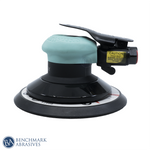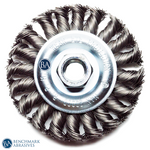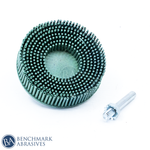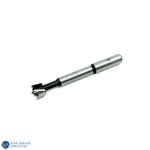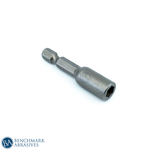
How to Choose the Right Sandpaper For Your Work

Sandpapers are composed of various materials with different characteristics. It is used for creating a smooth finish on metal. Different sandpapers work differently on materials; some wear out quickly, while others can last through multiple tough jobs before losing their bite.
Suppose you're looking to make the simplest version of your woodworking or metal projects. In that case, sanding is a crucial part of the process, whether you're rough sanding to get rid of jagged edges, deburr, preparation for gluing, or finishing and polishing stages.
Each of those steps requires different sandpaper grits to urge the most superficial results. Still, the grain type also will impact your overall results – and believe it or not; it's going to even be best for various classes.
So, choosing the right sort of abrasive is going to be critical.
What is Sandpaper?
Sandpaper is sheet coated with abrasive, meaning it's made up of some abrasive "grain," which is affixed to some quiet backing – often paper, cloth, plastic, or maybe foam sponges or mesh. There may or might not be other added fillers or coatings, like stearation.
How to Choose the Right Sandpaper?
These days, there are several sorts of abrasive materials used on sandpaper products, including a couple of natural rocks/minerals and a couple of synthetic substances, manufactured in labs, each with their advantages and drawbacks.
The most common natural minerals utilized in abrasives are emery and garnet, while the four common humanmade types are carbide, alumina, ceramic alumina, and alumina-zirconia. Each varies in longevity, coarseness/aggressiveness, amount of friction required, friability, cost, ideal application, available grit sizes, and coating and what formats of products they're available on, like disks, sheets, or Sanding belts.
Sandpaper Grit Size
For choosing suitable sandpaper, manufacturers identify a coarseness level. It is essentially a variety of grit sizes that are similarly effective for equivalent sanding work.
Extra coarse sandpaper
The 24- to the 36-grit range is hard stuff. It's used for removing paint and polish that you think might never come off. The sanding of old floors can also require the abrasiveness of additional coarse sandpaper.
Coarse sandpaper
It's suitable for rough shaping of wood and, therefore, removing previous finishes, like light coats of polyurethane. Coarse grits are typically within the 40- to 50-grit range.
Medium sandpaper
Starting from 60- to 100-grit, accommodates some final shaping. Primary sanding of rough wood and therefore removing designing marks on wood is usually best through with medium-grit sandpaper.
Fine sandpapers
It ranges from 120- to 220-grit. For many home workshops, this sandpaper will suffice for final sanding before the work is finished.
Extra fine sandpaper
It is usually used for sanding paint or varnish. Very fine sandpaper has grit sizes of 240, 320, or 400, while superfine sandpaper features grits of up to 600, which are best-suited for polishing jobs.
Sandpaper Abrasive Material
Not only does the density of sandpaper grit make a difference within the success of your sanding project, but the abrasive does, too. Some grit grains are better suited to smooth and sand types of materials (wood versus metal, for example). Most manufacturers list the sort of fabric best fitted to sanding on their product labels, but it's smart to understand what kind of grit to look for before you shop.
Flint
A natural grain, flint is durable and compatible for sanding off surface products, like old varnish or paint.
Emery
A natural grain, emery sandpaper is most frequently used for removing corrosion and polishing steel and other metals. The sides of its particles are often too sharp for sanding wood.
Garnet
Another natural grain, garnet, is slightly softer than flint or emery, so it tends to dull relatively quickly when used to sand metal. It's best-suited for fine sanding of wood.
Zirconia alumina
An artificial product, this grit is long-lasting and well-suited for grinding away burrs on metal and an initial sanding of rough wood. When sanding metal with zirconia alumina, the grit particles can become sharper, so you won't need to change sandpaper frequently.
Aluminum oxide
Another very durable synthetic grit, alumina is compatible with sanding and polishing various sorts of metal, including bronze and steel, and being an honest choice for sanding all kinds of hardwoods.
Silicon carbide
The foremost durable of all synthetic abrasives. Carbide is sweet for sanding a good range of materials, including plastic, metal, hardwoods, and softwoods.
Sandpaper Backing Material
Sandpaper was originally backed with paper—hence the name—but lately, you'll also find it backed with fabric or film, which helps make it longer-lasting. Fabric-backed sandpaper is often used dry or wet. Sanding with water or another lubricant helps to hold away the dust formed during sanding, reducing scratches and keeping the dust out of the air. It also prevents the sandpaper from getting clogged, so it lasts longer.
Paper
If the material needs flexible sanding, then choosing a lighter weight paper is a better choice. However, paper with a heavier weight is more robust and fewer likely to tear.
Cloth
Cloth gives excellent durability and adaptability, offering resistance to ripping and tolerating continual blending and flexing during use. Cloth-backed sandpaper is used for dry sanding operations and is ideal for heavy material removal. It is often suitable for tearing into strips and for using for contours, like stair spindles.
Best Suited Sandpaper for Job
Different tasks involve different Sandpapers:
- Shaping wood: Garnet, alumina, or zirconia alumina, 80-grit or lower
- Removing mill marks and other flaws in wood: Garnet, 100-grit or lower
- Sanding hardwoods: alumina, 100- through 220-grit
- Smoothing bare wood before painting: Garnet or alumina, 100- through 220-grit
- Smoothing raw wood before staining: Garnet or alumina, 100- through 150-grit
- Sanding painted or primed wood in fitness, before painting: alumina or carbide, 180-grit
- Sanding painted or primed wood in poor condition before painting: alumina or carbide, 80-grit; follow that with a coat of primer
- Removing raised wood fibers: Garnet, 180- through 320-grit
- Sanding the sides of a door that sticks: 80-grit
- Sanding old floors: Garnet, 80-grit or lower
- Grinding burrs off of metal: Zirconia alumina, 80-grit or lower
- Removing rust from metal: alumina, 100-grit or lower
- Preparing bare metal to color it: alumina, 150-grit
- Stripping paint or varnish: Any type, 100-grit or lower
- Smoothing between finishes (such as lacquer, shellac, or paint): alumina wet-or-dry, 220- or 280-grit
- Sanding drywall: Any type, 80- to 150-grit
- Smoothing joint compound: Start with a 120- or 150 -screen, then sand with carbide 150-grit
- Sanding grout to get rid of stains: Any type, 100-grit












